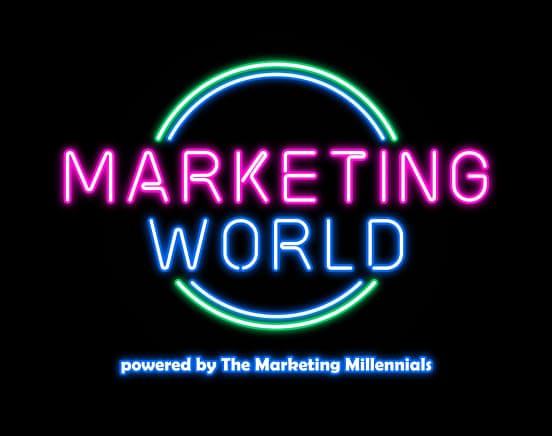Today’s guest dropped some FIRE actionable tips to level up in your Marketing career. Wait, was that too Gen Z?
Anyways Bestie, meet Kyle Lacy.
Currently the CMO at Jellyfish, an Engineering Management Platform, Kyle has experience leading teams of over 200 people.
He has climbed the corporate ladder and holds ALL the knowledge you need to get that promotion you’ve been working so hard for.
Let’s see what Kyle had to say on the 131st episode of The Marketing Millennials Podcast, in his own liiiightly edited words.
1. How to advance your career in marketing:
“Show impact.
Show the impact you’re having on business line objectives. Set goals that align to the business and not just marketing metrics (THIS).
That could be identifying how your content is driving revenue. Or showing how the event and community strategy you launched, affected customer retention.
Then consistently communicate that impact. Do that via email, one-on-ones, or Slack (be persistent).
“Hey CEO, I feel like I need a promotion. Here’s all the impact that I’ve made in one sitting.”
Leadership will see your impact for the past year because they hear about it constantly.
You almost want to be annoying with the amount of impact that you’re having as a marketer or just as a professional.
A CMO should never walk in the room without knowing the impact you’re having.
2. Align marketing to this:
Align marketing to revenue. ♂️
If you don’t align marketing to revenue, especially in a high growth SaaS environment, you’re second tier to sales or customer service.
(Marketing Bestie, we work TOO hard to be second tier.)
Level up your marketing game
Zero BS. Just fun, unfiltered, industry insights with the game-changers behind some of the coolest companies from around the globe.
No spam. Unsubscribe any time.
And when budgeting or resource allocation discussions are had, marketing is secondary because you didn’t align objectives.
Show how marketing is driving and influencing revenue creation. Because businesses need to grow, especially venture backed.
3. Perfecting the 80/20 rule:
80% of your activities are going to be attributable and 20% is your test budget used for brand plays which aren’t as easily attributable.
The 80% should be managed down to the very tactical dollar. (Dollar goes out, dollar comes in, you’re ON it.)
When you try to measure brand plays, like direct mail or event, it dampens the creativity of the team because they’re so worried about getting pipe in the room.
That doesn’t mean you shouldn’t look at the impact that it’s having for the business line. After all, you want to connect budget to brand in order to get more of it.
But you want to make sure the experience that the person is having is paramount.
When marketers come into the room and talk about metrics or ROI first during a brand play, they usually are sh*tty brand experiences (we’ve ALL had a couple of these).
They’re too worried about a return on their investment; they forget about the experience for the consumer.
You can attribute all day long, but the efficiency of your investment and attribution modeling when it comes to pay channels is more important than with brand plays.
4. How Marketing and Sales should collaborate:
If a sales rep is touching a lead that marketing gave them, that lead should be ready to at least have a conversation.
They requested a demo, went through a product tour, or they’re using a free trial.
If marketing’s not doing that, then you’re not marketing correctly (mic drop).
Udi Ledergor from Gong is known for saying it’s Marketing’s job to make sales easier.
(I will quote him all day long on that.)
It’s true, especially in a sales led org product.
The thing marketers get wrong is that they think a regurgitation of a metrics report is what you should show your Sales team. WRONG.
Tell a story to sales and put it in their vernacular. Tell the story how they want it told and they’re going to remember it.
Show the impact you had on your reps meeting quota (if you do this, you will have a new BFF).
If sales isn’t doing what you want them to do, it’s because you’re doing a sh*tty job telling the story of what you’re doing (retweet).
If you’re doing the right thing, they’re going to want it and they won’t leave you alone. It will get annoying about how much they want to work with you.
5. How to ask for more resources as a Marketer:
You first have to ask yourself a question: Am I prioritizing my time and my team’s time appropriately?
Too often marketers feel they have to get a lot done to feel accomplished.
They need to feel busy. There’s dopamine everywhere, check the box. It doesn’t matter what it is, you’re doing everything and making an impact everywhere. Dopamine hits all over the place.
(Sounds like 23 year old me trying to figure out the Marketing world – LOL.)
That’s the quickest way to burn out. THEN you say, I need more resources.
But the reality was, you weren’t prioritizing what you should have been working on to begin with.
That also could mean that your marketing leader is prioritizing your time inappropriately.
Let’s say you are prioritizing your time appropriately and need more resources.
Here’s what to do: Can you show business impact and do you have a business case for the resources you need?
Business case means here’s the object, here’s how it’s going to improve what we’re doing from a business perspective, and here’s the investment that I need.
(Absolutely love this clarity.)
If your reasoning is that your team’s too busy, that’s not a business case. Stop doing half of what you’re doing and prioritize tasks.”



